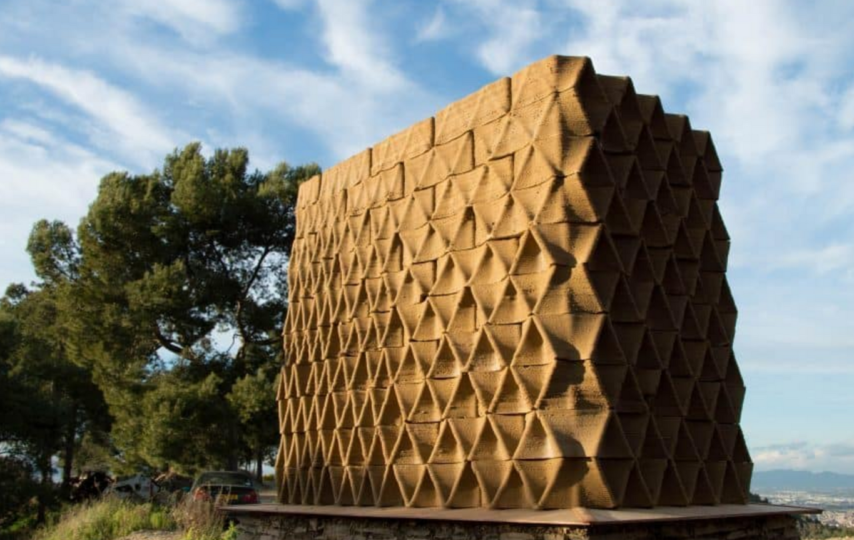The construction sector could benefit from technological advances in graphene for future structural, cladding and energy efficiency applications in building construction. The high thermal and electrical conductivity of graphene , in addition to its extreme elasticity and hardness, has focused most of its field of application in leading sectors such as electronics or energy .
However, the extreme lightness and resistance of this supermaterial could extend its field of application to other sectors such as architecture and engineering, based on the significant advantages that graphene could offer in the construction of buildings. In fact, there are experts in the construction sector who value the advantages that this revolutionary material can offer, even going so far as to displace the use of conventional equipments such as concrete and steel, in the long term.
From concrete to graphene, this is how architecture will change in the coming years FUTURE
Graphene in construction
Hardness and resistance
One of the most valued characteristics of this supermaterial is its extreme hardness , estimated according to tests carried out at about 200 times that of steel . Its ability to absorb energy before breaking and withstanding large loads, makes graphene a worthy competitor to materials as hard as diamond. Qualities such as its high resistance to punching , traction or wear make graphene the perfect candidate to relieve steel or concrete of its functions as a traditional material for structural use.
Elasticity and Flexibility
In addition, its high elasticity and flexibility significantly reduces its resistance to wear and fatigue . A very interesting aspect from the structural point of view since the presence of cracks and fissures during the useful life, reduces the mechanical capacities of the load-bearing structures , being the origin of many of the pathologies of the current real estate stock.
Its great flexibility would also allow the material to be molded to adapt it to the nature of the construction design, with interesting applications as an exterior or interior cladding material , but also as a structural reinforcement element in building rehabilitation and renovation projects .
Russian Scientists discovered graphene
They were the scientists of Russian origin, Andréy Geim and Konstantín Novosiólov, of the University of Manchester, those who discovered graphene in 2004. They managed to separate, from a graphite extract, a graphene sheet the thickness of a single atom.This new material had extraordinary qualities and could be used not only for manufacturing of new materials from it but opened many possibilities of application in different fields.Such was the relevance of their finding that Geim and Novosiólov received the Nobel Prize in Physics in 2010 for discovering this revolutionary material to the world.
Graphene and its properties
Graphene has a number of almost wonderful qualities that are slowly gaining popularity as a supermaterial.Many industrial sectors have already had their eye on it. However, construction is perhaps one of the most popular. It could take you out and where the greatest potential is being seen as it could serve to improve energy efficiency and reduce the environmental impact of buildings.
High thermic and electric conductivity
These two are his most celebrated properties. Graphene is capable of conducting electricity a lot better than copper because it needs much less electricity to carry the same amount of energy as the latter. At the same time, it allows the sun’s rays to be converted into electricity instantly because it has the ability to capture light and convert it into energy.
Graphene is up to 200 times harder than steel, some experts even place it as the main competitor to diamond.This makes it especially suitable for supporting large volumes of weight.
It is also very resistant to both friction and inclement weather.In this way, the materials made from graphene will last over time, much longer than their predecessors.
Flexibility and lightness
Graphene is extremely flexible, a quality that makes it a highly moldable material and therefore suitable for a multitude of uses and applications.On the other hand, it is very light, much more than aluminum. And, in addition, it is transparent.This is perhaps not a quality but a description but together with its flexibility makes it ideal for manufacturing.from computer screens or other electronic devices, especially computers, smartphones or tablets.
Thermal and electrical conductivity
Facilities are an indispensable part of the functioning of a building, and in this field, graphene has a lot to contribute. Good thermal conductivity, that is, its ability to conduct heat through its mass, can have interesting applications in improving the performance of building air conditioning and conditioning systems .
On the other hand, its electrical conductivity far exceeds that of copper, a material that is usually used as the basis for the manufacture of electrical cables . A key aspect that could improve the efficiency and performance of electrical installations . But not only that, its excellent properties as a semiconductor is revolutionizing sectors such as energy, with applications that will improve the efficiency of future generations of photovoltaic cells to come.
Transparency and lightness
As we have commented previously, its use as a future material with a structural nature is reinforced by its extreme lightness. The idea of being able to create unique structures that are much stronger and lighter is an indisputable advantage in the architectural design process and a significant reduction in construction costs in the case of unique constructions.
Its transparency and flexibility, on the other hand, would complete the catalog of applications as a cladding material for the building envelope. In this case, with transparent and flexible surfaces much more economical , resistant and versatile than the current use of tempered glass pieces.
graphene in construction
Resistance to ionizing radiation and phytosanitary properties
To conclude with the range of applications of graphene in the construction of buildings, it should be noted that its resistance to ionizing radiation could be especially interesting in areas such as healthcare . Where the use of graphene as a material for isolating the radiation emitted by radiotherapy or magnetic resonance equipment would mean significant savings in the economic cost of building future clinics or hospitals.
In addition, its phytosanitary properties open a myriad of applications as an antibacterial coating material within the food industry , biomedicine and even in sectors such as hotels and restaurants.










